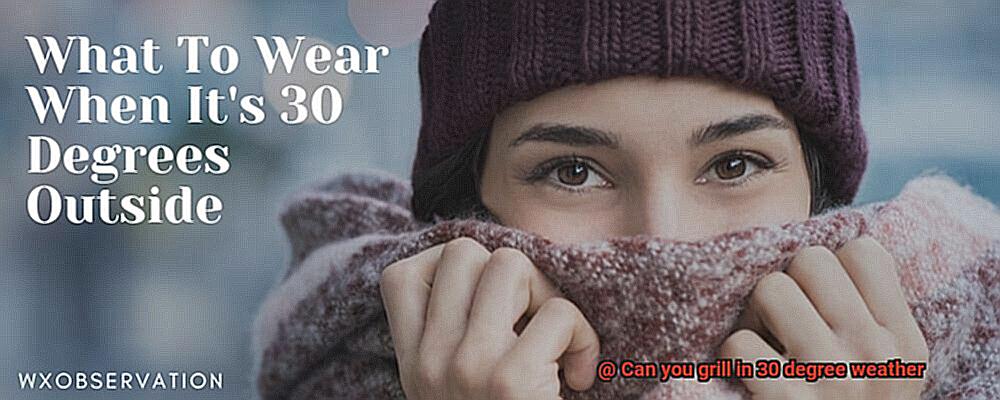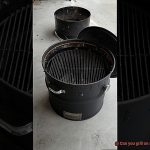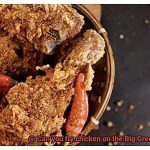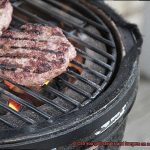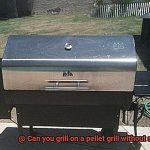Are you a die-hard grill master who can’t bear to be cooped up inside during the winter months? Do you crave the smoky flavor of grilled meats and veggies even when the thermometer reads a chilly 30 degrees? Well, you’re in luck because grilling in cold weather is not only possible but also incredibly satisfying.
Don’t let the frosty air put a damper on your outdoor cooking dreams. With some careful planning and equipment adjustments, you can still enjoy juicy steaks, crispy chicken wings, and perfectly charred vegetables all year round. In fact, grilling in cold weather can add an extra layer of excitement to your cookout and impress your guests with your fearless spirit.
But before you fire up the grill, there are some factors to consider to ensure success. Cooking times may need to be adjusted due to the colder temperature, and food safety should always be a top priority. Plus, preparing your grill for cold weather requires some extra TLC to keep it hot and maintain its quality.
In this blog post, we’ll dive deeper into these considerations and share some expert tips on how to overcome them. From preheating your grill properly to using insulated gloves for handling hot surfaces, we’ve got you covered.
So, if you’re ready to brave the elements and take your grilling game to the next level, read on for our top tips on grilling in 30-degree weather. Let’s get cookin’.
Contents
What to Consider When Grilling in 30 Degree Weather
Grilling is a beloved pastime for many, but when the temperature drops below freezing, it can be a daunting task to cook outdoors. However, with a little preparation and attention to detail, grilling in 30-degree weather can still result in a safe and delicious meal. Here are some factors to consider:
Grill Type
When grilling in cold weather, the type of grill you use can make a significant difference in your experience. Gas grills tend to be more efficient than charcoal grills and easier to regulate in colder temperatures. Charcoal grills may require more time and effort to heat up and maintain a consistent temperature.
Food Type
The type of food being grilled also matters when cooking in cold weather conditions. Thick cuts of meat or dense vegetables may take longer to cook, which can be challenging when the temperature is low. Pre-cooking some items or investing in a meat thermometer can ensure that food is cooked all the way through without overcooking or burning.
Clothing and Protective Gear
Dressing appropriately for the weather is crucial when grilling outside in 30-degree temperatures. Layering clothing can help regulate body temperature while also providing protection from wind and cold temperatures. It’s also important to wear gloves to protect hands from the cold and potential burns from hot grill surfaces.
Safety Precautions
Safety should be a top priority when grilling outdoors, especially in cold weather conditions. Avoid using lighter fluid or other accelerants that can be dangerous in colder temperatures. Ensure that the grill is placed on a stable surface away from flammable materials and keep a fire extinguisher nearby.
Preheating Your Grill
In colder temperatures, it’s essential to preheat your grill for an extra 5-10 minutes to ensure that it reaches the desired temperature. Cold temperatures can cause your grill to take longer to heat up, which can impact cooking times and lead to undercooked or overcooked food.
In conclusion, grilling in 30-degree weather requires extra attention and preparation to ensure a safe and delicious result. By taking these factors into account, grilling in cold weather can still be an enjoyable experience for any outdoor cooking enthusiast.
Cleaning and Maintenance for Your Grill
As winter sets in, it’s time to take your grilling game to the next level. But before you do, make sure to give your grill the care it needs for optimal performance. Cold temperatures and moisture can cause rust and damage to your grill, so cleaning and maintenance are essential. Here are some tips from an expert to help you keep your grill in tip-top shape during cold weather.
Thoroughly clean your grill after each use
Cleaning your grill after each use is essential to its longevity. Start by scraping any leftover food particles off the grates. Use a wire brush or scraper to do this. Then, wipe down the exterior with a damp cloth. Don’t forget to clean out the grease tray as well. For a deeper clean, you can remove the grates and clean them with soap and water.
Protect your grill with a waterproof cover
When not in use, protect your grill from snow and rain damage by covering it with a waterproof cover. This will also help keep it dry and prevent moisture buildup.
Perform maintenance on your grill before and after winter season
To ensure that your grill is ready to use in any weather condition, perform maintenance on it before and after the winter season. Check the gas lines for leaks, inspect the ignition system, and replace any worn or damaged parts.
Keep your grill dry
Moisture is one of the biggest enemies of your grill during cold weather. Store it in a dry place when not in use. You can also use a moisture absorber or silica gel packets inside the grill to soak up any excess moisture.
Use high-quality cleaning products
Using high-quality cleaning products can help extend the life of your grill. Look for products specifically designed for grills that are safe for use on stainless steel and cast iron surfaces.
Fuel Types for Grilling in Cold Weather
Grilling in cold weather can be a challenge, but with the right fuel type, you can ensure your food cooks properly and tastes delicious. Let’s explore the different fuel types that work well for grilling in low temperatures.
Propane
If you’re looking for a reliable fuel source, propane is a popular choice. Propane tanks are easy to find and offer consistent heat, even in freezing temperatures. Additionally, propane grills typically have an ignition system that doesn’t require matches or a lighter, making it easier to start your grill in cold and windy conditions.
However, it’s important to note that extreme temperatures can affect propane tanks, so be sure to store them in a warm place or cover them with an insulated blanket.
Natural Gas
For those with a natural gas line connected to their home, natural gas is a convenient and cost-effective fuel option. Natural gas grills heat up quickly and maintain a consistent temperature, making them ideal for cold weather grilling. However, if you don’t already have a natural gas line installed, it can be expensive to add one just for your grill.
Charcoal
Charcoal is a favorite among grilling enthusiasts for its smoky flavor. However, using charcoal in cold weather can be challenging as it takes longer to heat up in low temperatures. To combat this issue, use a chimney starter to preheat the charcoal before adding it to the grill. Additionally, using a charcoal grill with a lid can help retain heat and keep the temperature consistent.
Wood Pellets
Wood pellet grills use compressed sawdust pellets as fuel, producing a smoky flavor in your food. They’re also easy to control the temperature on and provide consistent heat regardless of outdoor temperature. Wood pellets are an excellent option for those who want the smoky flavor of charcoal without the hassle of preheating.
Extra Fuel
No matter which fuel type you choose, it’s essential to keep extra fuel on hand in case you run out unexpectedly. In cold weather, fuel consumption may be higher than usual due to the need for constant heat. Be sure to stock up on extra fuel so you won’t have to make a last-minute run to the store.
Lighting Charcoal for Grilling in Cold Weather
Winter is no longer an obstacle to enjoying sizzling, grilled food. However, one of the most significant challenges when it comes to grilling in cold weather is lighting charcoal. Fear not, though – with the right techniques and tools, you can get your charcoal going in no time.
Firstly, ditch the lighter fluid and opt for a chimney starter instead. Lighter fluid can be tricky to ignite in colder temperatures and may emit harmful fumes. A chimney starter uses paper or kindling to start a fire that will ignite the charcoal.
Secondly, ensure that your charcoal is dry. Moisture can make it difficult for the charcoal to ignite. So, keep your charcoal in a dry place and cover it with a tarp or plastic bag if you’re grilling in snowy or wet conditions.
To get your charcoal going in cold weather, use a blowtorch or handheld propane torch to light the kindling in your chimney starter. Alternatively, use an electric heat gun or hair dryer to blow hot air onto the kindling until it ignites.
Once your charcoal is lit, remember to keep it covered with a lid or foil pan to help retain heat and prevent it from going out. Adding more charcoal during the cooking process may also be necessary to maintain a consistent temperature.
In summary, here are the top tips for lighting charcoal for grilling in cold weather:
- Use a chimney starter instead of lighter fluid
- Ensure that your charcoal is dry
- Use a blowtorch or handheld propane torch to light the kindling
- Keep your charcoal covered once it’s lit
- Add more charcoal during the cooking process if necessary
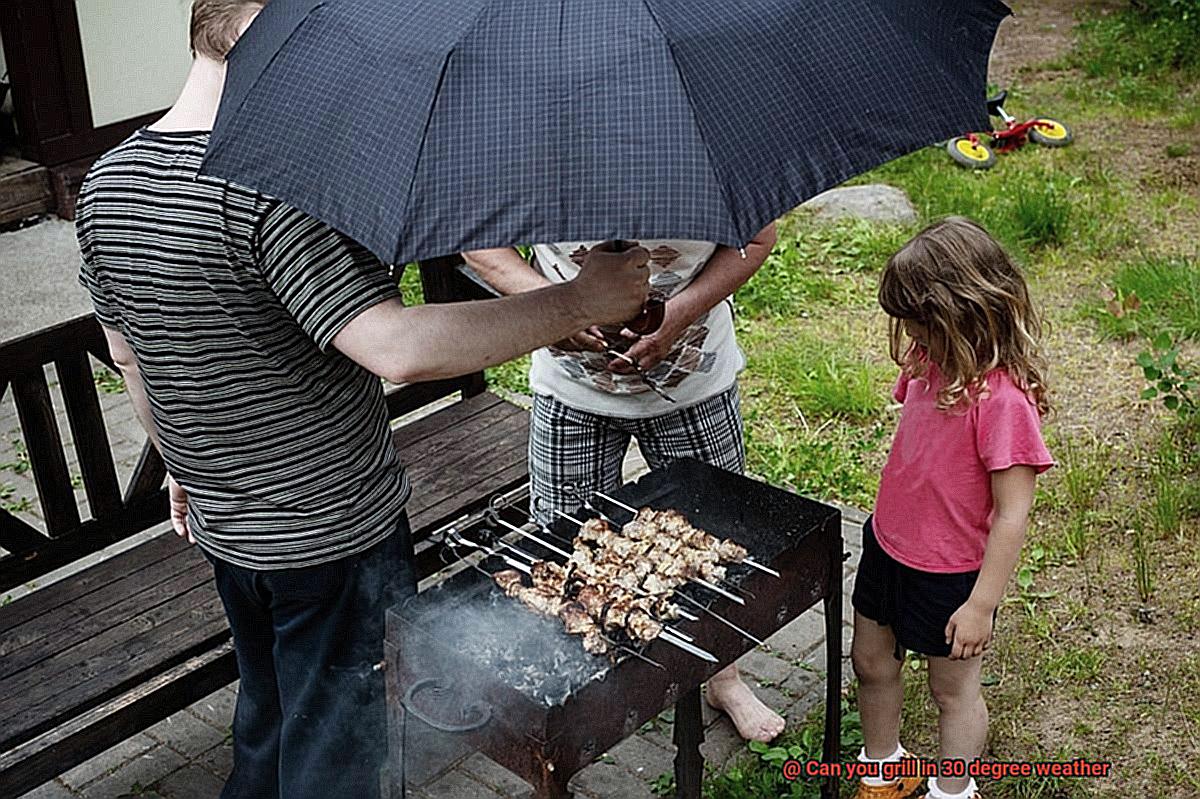
Preheating the Grill Before Cooking
Before you start cooking, make sure to preheat your grill properly. As an expert in grilling, I’m here to tell you why preheating is so important and how to do it right.
First and foremost, preheating the grill is essential, especially in chilly weather. When temperatures drop, your grill will take longer to heat up. To avoid uneven cooking and food that sticks to the grates, preheat your grill for at least 15-20 minutes before cooking.
To ensure that your food cooks evenly and doesn’t stick to the grates, follow these simple steps:
- Clean Your Grates: Use a wire brush or scraper to remove any debris or leftover food from previous grilling sessions. This will help prevent sticking and ensure that your food cooks evenly.
- Turn on the Burners or Light the Charcoal: Depending on the type of grill you have, turn on the burners or light the charcoal and close the lid. Allow the grill to heat up until it reaches around 400-450 degrees Fahrenheit.
- Gas Grill Safety: If you’re using a gas grill, turn off all burners and close the lid when you’re finished cooking. This will help keep your grill clean and prevent any leftover food from sticking to the grates.
By preheating your grill properly, you’ll be able to cook your food evenly and achieve those beautiful sear marks we all love. Don’t rush this important step – take the time to preheat your grill and enjoy perfectly cooked food every time.
Adjusting Cooking Times and Methods
Well, don’t let the cold temperatures dampen your grilling spirit. With a few adjustments to your cooking times and methods, you can still enjoy deliciously cooked food even in 30 degree weather.
To start off, preheating your grill for a longer period than usual is crucial. The cold temperature can cause your grill to lose heat quickly, so be sure to preheat for at least 15-20 minutes before you start cooking. This way, you’ll be sure that your grill reaches the desired temperature and stays there throughout the cooking process.
Next up, consider increasing your cooking time. The chilly weather can slow down the cooking process, so don’t rush it. Give your food a bit more time on the grill and keep an eye on it. Using a meat thermometer to check for doneness is also important to ensure that your food is cooked through.
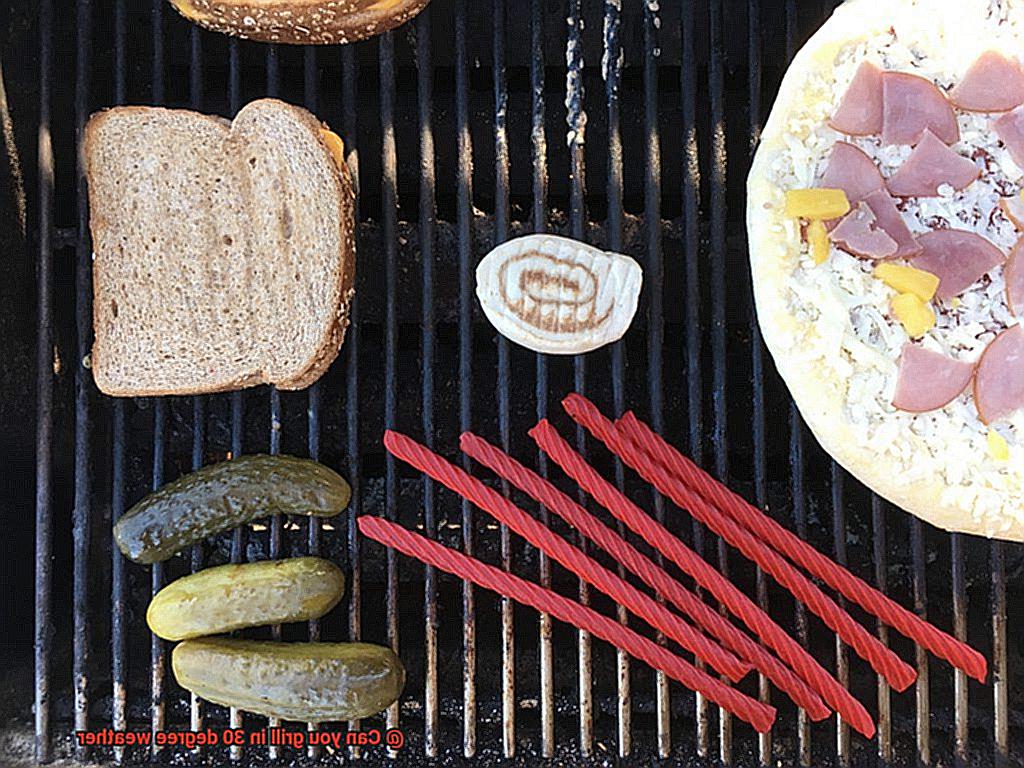
Another great adjustment to make when grilling in cold weather is using indirect heat. This method involves turning off one side of the burners and placing your food on the other side. This creates a warmer area for your food to cook without being directly exposed to the cold air. It’s an easy way to ensure even cooking and avoid any cold spots on your grill.
Finally, don’t forget about the wind. Windy conditions can also affect the temperature of your grill and cause uneven cooking. To avoid this, try to choose a spot that is sheltered from the wind or use a windbreak to protect your grill from gusts of wind.
Tips and Tricks for Grilling in 30 Degree Weather
Grilling in the cold weather can be challenging, but with the right tips and tricks, you can still achieve mouth-watering results. Here are some simple ways to make your grilling experience a success even when the temperature drops below freezing.
Keep Your Grill Clean and Well-Maintained
When it comes to grilling in cold weather, one of the most important things to keep in mind is to keep your grill clean and well-maintained. This means cleaning the grates before and after each use, checking the fuel levels, and inspecting the burners for any blockages. A clean grill not only ensures better-tasting food but also reduces the risk of flare-ups or other issues that could arise from built-up grease or debris.
Preheat Your Grill for an Extended Period
In cold weather, your grill may take longer to reach the desired temperature. To compensate for this, preheat your grill for an extended period before placing your food on the grates. This will help ensure that your food cooks evenly and thoroughly.
Use a Grill Cover
When not in use, make sure to cover your grill with a heavy-duty cover to protect it from the elements. This will prevent any snow or ice from accumulating on the grill and potentially damaging it. Additionally, a cover can help maintain the grill’s temperature as it prevents heat from escaping.
Create a Windbreak
Wind can have a significant impact on the temperature of your grill when grilling in cold weather. To prevent this, consider creating a windbreak around your grill by using plywood or cardboard to shield it from gusts of wind. This will also help maintain a consistent temperature inside the grill, ensuring that your food cooks evenly.
Choose Thicker Cuts of Meat
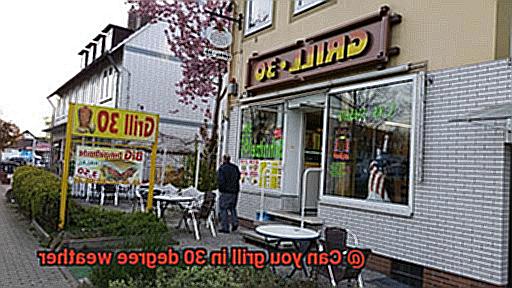
Thicker cuts of meat like ribeye, strip steak, or pork chops are better suited for grilling in colder temperatures as they hold up better during longer cooking times. You may also want to consider pre-cooking certain items in the oven before finishing them on the grill. This will reduce the cooking time and ensure that your food is cooked thoroughly.
Dress Appropriately for the Weather
When grilling in cold weather, it’s essential to dress warmly and appropriately. This includes wearing gloves, warm clothing, and having hot beverages on hand to help keep you warm while you grill. Additionally, make sure to keep a close eye on your grill and never leave it unattended.
LGLk6tqoZrg” >
Conclusion
In conclusion, grilling in 30 degree weather is not only possible but also immensely satisfying. Imagine the smell of sizzling steaks, the sound of juicy burgers cooking to perfection, and the taste of perfectly charred vegetables – all enjoyed in the crisp winter air. However, before you start up your grill, there are crucial factors to consider.
Firstly, it’s essential to choose the right type of grill and fuel for cold weather conditions. Propane or natural gas grills offer quick heating and easy temperature control while charcoal or wood pellet grills provide a smoky flavor. Secondly, adjusting your cooking times and methods is necessary to ensure even cooking in low temperatures.
Moreover, dressing appropriately for the weather and taking safety precautions such as keeping a fire extinguisher nearby are essential when grilling in cold weather. Preheating your grill properly and using a cover or windbreak can also help maintain consistent heat levels.
Lastly, keeping your grill clean and well-maintained is crucial for optimal performance during winter months. Regular cleaning prevents grease buildup that can lead to flare-ups while maintenance ensures that all parts are functioning correctly.
In summary, with careful planning and adjustments, grilling in 30-degree weather can be an enjoyable experience.

